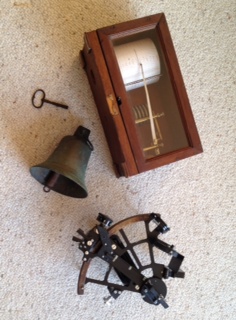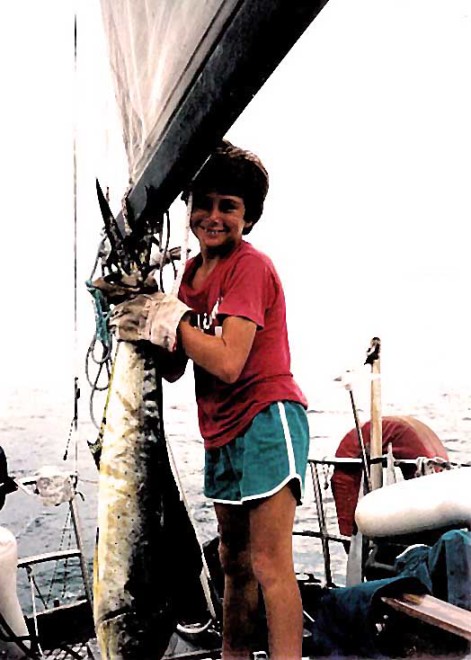Ode to My Kitchen Tongs and Other Sentimental Ditties
/I had a minor catastrophe in my kitchen the other day, here in California, and I practically shed a tear. Really. My beloved kitchen tongs broke. Really??? Just like that old sweater you can't bring yourself to throw away, we have a few such vestiges from Cowabunga that we still can't live without. One of my dearest, trusty items is an unlikely pair of plain old, gadget-store, low-grade stainless steel kitchen tongs. Nothing fancy. Yet, these tongs can tell a tale. In the over 30-odd years that I have had them, they served me well: first during our 10 years on Cowabunga, and the many years since then here on land.
I bought them in some nondescript "Ace Hardware" type general store in France, even before Brendan was born, I believe, so yes, they must be over 30 years old. During our life on the boat, they succumbed at one point to one-too-many saltwater dishwashings, and the main hinge screw rusted out one day. Being somewhere geographically isolated at the time, it was not an option to go out and buy a new pair, and I needed this kitchen tool, constantly! So, Michel, handy that he is, was able to scrounge up a stainless steel screw from his onboard tool, “treasure” chest, and replace it, and they have lived on to see many another day, and many cooking adventures on into this 21st Century—a good 23 years or so later since we disembarked. No, I can't, I WON'T cook without them! Then, just a few days ago, here in my kitchen in California, these same heroic tongs broke. The main spring had sprung for the last time. I couldn't believe it. I was practically heartbroken. This can't be! They survived our whole life on the boat; it's not now they are going to give up the ghost! Both Michel and I looked at each other: The end of an era? All that history up in smoke, poof, just like that? This was silly. So emotional for a pair of cheap, and I really mean cheap, kitchen tongs!
No, this story wasn't going to end like this. We shall overcome, and Michel was determined that these tongs could, and would, be fixed again! So off he went on a quest to find a replacement spring. He came back empty handed. Then I remembered that I seen some cheap-type, similar looking tongs at our own local Ace Hardware in their kitchen-gadget department. Lo and behold, there seemed to be an almost identical pair, but I was only interested in getting the inside spring—the guts. Nevertheless, I purchased it, brought it back to my handy hubby, and he promptly cannibalized it, repairing our trusty old pair with the exact same spring, and eureka, it lives anew! If we can get another 30 years out of it, I’m pretty sure it will outlive us, and my family can be sure that some lucky soul will be inheriting this storied item in my will.
This sentimental incident got me thinking about a few other items that Michel and I still have and sometimes use daily, that originated from our long life onboard Cowabunga. Another item I practically use several times a week is a Lagostina pressure cooker. A household in France cannot survive without a pressure cooker and thus I learned to use this handy item when I lived there. I purchased this 6 qt. pot some time before we set sail from France and for our 10 years onboard it was a workhorse. It was even an excellent safety device, cooking whole meals encapsulated and enclosed in its own secure space as it rocked on the gimbaled stove while we sailed along. The salt water too played havoc with the pot and over the 10 years I had to replace the rubber lid seal and the pressure relief valve several times. But since our arrival in California in 1990, it still has the same seal and valve since the last replacement, and has prepared many a winter stew and soup for our family of four. On the boat it was my yogurt maker, canning device, and sometimes a bread oven as well.
Today Michel’s garage-sized workshop is quite an improvement over the tiny inside passageway he had once commandeered for his tools and workbench on the boat. But with his current fully-equipped space on land, that hasn’t stopped him from using his favorite childhood hammer with which he not only practically rebuilt the whole inside of Cowabunga, but continued to pound away for years renovating our current, now fixed-up “fixer-upper.” As it turns out, this hammer manufactured in France over 50 years ago is rather distinctive. Being of French character, it sports, of course, a spirit contrary to that of a typical American hammer. I guess that just goes with the territory. As Michel has demonstrated to me, American hammers have round heads with a claw on one end for removing nails. His French-styled hammer has a squared-off head, almost “mini sledge hammer-like,” and no claw. It just hammers. But not only that, he uses it as fondly as he did the day he bought it with his own precious savings at 14 years old! It seems at the time his father was rather irate that Michel kept wanting to borrow his tools, so Michel proudly bought his own hammer, and like man’s best friend, it has followed him everywhere: from the north of France to the south, across the Atlantic, to the West Coast of the United States. He has “known” his hammer longer than me.
Another one of Michel’s treasured belongings is the very trustworthy, valuable antique barograph that was our constant weather forecaster onboard Cowabunga. His dear friend, Philippe, gave it to us just before we set sail from France. It had been in Philippe’s family since the 1870s and has the unique feature of using an eight-disc pressure gauge. Michel and Philippe were very close, and Philippe was sad and somewhat distraught that we were leaving. This was his way of sending a part of him along with Michel. This barograph had a superb sense of the future with an uncanny ability to let us know what kind of weather was going to aspire in the next 24 hours. When that inked needle dipped very low on the sheet as it turned around the 24-hour “barrel,” a line that snaked from the median “norm” to a low atmospheric pressure setting was not an encouraging sight, and we couldn’t say that we were not forewarned. It predicted the good and the bad, and it was always dependable. Once we dismantled Cowabunga, the barograph was stowed away in a closet for 10 years. One day Michel came across it, wound up, and the old trusty “tick, tick, tick” went right to work as it had always done. Now it sits prominently on a shelf among other valued positions, faithfully predicting our weather here on land. It has survived Philippe, and we think that he and his ancestors from the 1870s would be proud.
Family Heirlooms
And then there are the mementos from Cowabunga, pure and simple, now working their way into veritable heirloom status within our family. Sean began to discover a liking and a talent for fishing. We would most often trail a fishing line during a passage, and more often than not, a good many of the fishing lures would disappear usually munched off by a shark or the “big one that got away.” Sean was probably around 10 years old and was getting the hang of fishing during one particular trip when we found ourselves bereft of lures when the last one disappeared. Sean figured they weren’t called “spoon lures” for nothing and confiscating one of my spoons, he asked that Michel drill two holes in the spoon: one at each end. With that done he was able to attach a fishing line at the stem end, and then a hook at the bottom of the cup of the spoon. He threw it into the water and promptly caught a hefty, beautiful bonito! And the lure survived. In fact it survived quite well and became THE fishing lure, bringing Sean a lot of success. One of his prized catches was a big dorado, (almost as big as him), that he caught off the Pacific Coast of Panama and that we ate heartily. Since his system worked so well, he commandeered two other spoons for a total inventory of three. Two of them have been framed for posterity, and one remains in my kitchen utensil drawer today—a daily reminder of that past.
When Brendan was 3 years old, he was enamored with the then-cartoon super hero strongman of the 1980s, “He-Man.” It’s ironic because today, Brendan is indeed a fitness and strength fanatic, an extremely talented and strong rock climber and runner. I don’t know if He-Man was the defining influence or not, but nevertheless, something must have rubbed off on him. We were anchored in the Intracoastal Waterway in Florida at the time, and the boys were about to experience their first Halloween. I’m not crafty, but I can sew a pattern and follow directions so I bought a Superman Cape kit, in the guise of a He-Man costume. Brendan loved it. In fact, so much so that he refused to take it off for a good year or so, if not more. He wore it to school, to bed, everywhere. I was mortified when he refused to take it off for our official photo shoot session with the Time Magazine photographer for photos that would accompany the feature article on us. His Superman cape was immortalized in the Time Magazine photo, and today I proudly display it on a wall in a poster-sized frame, with a copy of the Time article alongside. I think he merits this in my will.
On one wall in our home, along with the current photos of kids, grandkids and the treasured barograph, also sit a few other Cowabunga memorabilia curiosities: our visitor logbook, a quirky fireman’s wrench, our cabin bell, and our hallowed sextant. Occasionally we leaf through the logbook and friends and experiences from the past leap out at us from the pages. The cabin bell was required onboard equipment by French maritime law. The quirky fireman’s wrench, normally used to properly attach a fire hose to a fire hydrant, was the perfect tool Michel found to regularly tighten the gland seal in the stuffing box, in other words, minimizing leaks at the point where the engine drive shaft connected to the propeller at an opening in the hull.
The sextant is a miracle object all of its own. I have talked about it in other vignettes how it guided us every day for 30 days across the Atlantic Ocean, how it found “needles in haystacks” of tiny islands in the middle of nowhere, how it carried us to California, how it was never wrong. Satellite navigation on pleasure craft was in its infancy in the 1980s, and GPS systems were non-existent. We didn’t have enough money to buy an extensive radar system, so navigating with the sextant, just like the early explorers did, was our only option. But just as important is the memory the sextant evokes of our dear friend and mentor to Michel, Pierre. Pierre was a sailor on the weekends. He was smart, professional, successful, sincere, honest, and devoted to his family. He was a “father figure” for us, and encouraged us to follow this dream of our voyage; we were going to live his dream. Probably just about a week before we left, he sat Michel down on the beach, and gave him a lesson with the sextant. He demystified the whole process for Michel and I was forever grateful that Pierre gave us his “guiding light.” This ancient and beautiful device sits on our shelf today, just as ready to function as it always did. It embodies Pierre. Furthermore, it’s a beautiful object to look at, a work of technical engineering art.
Looking back on life on Cowabunga, and contemplating the longevity of these tools and mementos some 20 years on, it struck me how some of them were able to fit seamlessly into our new life on land, working alongside us, and others now occupy revered spots of privileged honor, an homage to our era past. Although it’s been over 20 years, it’s still very hard to think of Cowabunga without choking up. The day we had to let her go was just as hard as saying goodbye to a lifelong pet. But parts of her are still around us everyday, reminding us that the call of the ocean and other lands are not that far away.









